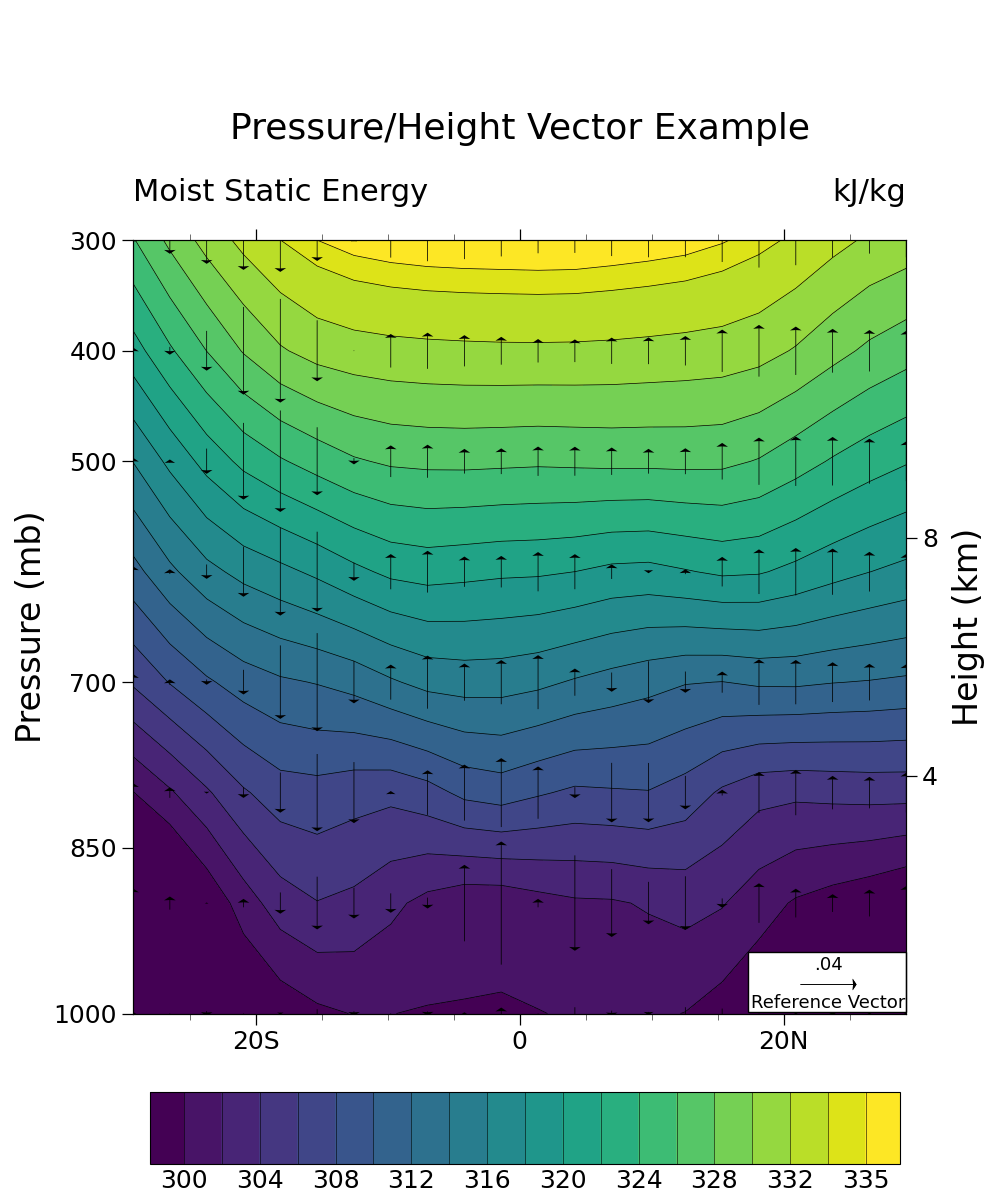Note
Click here to download the full example code
NCL_h_lat_7.py¶
- This script illustrates the following concepts:
Drawing vectors over filled contours
Drawing pressure and height scales
Interpolate to user specified pressure levels
Using the geocat-comp method interp_hybrid_to_pressure
Using a different color scheme to follow best practices for visualizations
- See following URLs to see the reproduced NCL plot & script:
Original NCL script: https://www.ncl.ucar.edu/Applications/Scripts/h_lat_7.ncl
Original NCL plot: https://www.ncl.ucar.edu/Applications/Images/h_lat_7_lg.png
Import packages:
import xarray as xr
from matplotlib import pyplot as plt
import numpy as np
import geocat.datafiles as gdf
from geocat.viz import util as gvutil
from geocat.comp import interp_hybrid_to_pressure
Read in data:
# Open a netCDF data file using xarray default engine and load the data into xarrays
ds = xr.open_dataset(gdf.get("netcdf_files/atmos.nc"), decode_times=False)
# Extract variables
T = ds.T # temperature (K)
V = ds.V # meridional wind (m/s)
Z = ds.Z3 # geopotential height (m)
omega = ds.OMEGA # vertical pressure velocity (mb/day)
lev = ds.lev # pressure levels (millibars)
lev = 100 * lev # change units to Pa
q = ds.Q # specific humidity (g/kg)
q = q / 1000 # change units to kg/kg
# Calculate moist static energy (h)
g = 9.81
L = 2.5e6
Cp = 1004.0
h = Cp * T + g * Z + L * q
h = h / 1000 # Convert to kJ/kg
# Convert h and omega to pressure levels
hyam = ds.hyam
hybm = ds.hybm
P0mb = ds.P0 * 0.01
ps = ds.PS
ps = ps / 100 # Convert from pascal to millibar
lev_p = np.array([300, 400, 500, 600, 700, 800, 900, 1000])
# interp_hybrid_to_pressure is the Python version of vinth2p in NCL script
hp = interp_hybrid_to_pressure(data=h,
ps=ps,
hyam=hyam,
hybm=hybm,
p0=P0mb,
new_levels=lev_p,
method='log')
# Assign attribute values
hp.attrs['units'] = "kJ/kg"
hp.attrs['long_name'] = "Moist Static Energy"
op = interp_hybrid_to_pressure(data=omega,
ps=ps,
hyam=hyam,
hybm=hybm,
p0=P0mb,
new_levels=lev_p,
method='log')
vp = interp_hybrid_to_pressure(data=V,
ps=ps,
hyam=hyam,
hybm=hybm,
p0=P0mb,
new_levels=lev_p,
method='log')
# Extract slices of the data
hp = hp.isel(time=0).sel(lat=slice(-30, 30)).sel(lon=210, method='nearest')
op = op.isel(time=0).sel(lat=slice(-30, 30)).sel(lon=210, method='nearest')
vp = vp.isel(time=0).sel(lat=slice(-30, 30)).sel(lon=210, method='nearest')
# Set vp equal to zero so that we plot only the vertical component
# while retaining the coordinate information
vp = xr.zeros_like(vp)
Plot:
# Generate figure (set its size (width, height) in inches)
fig = plt.figure(figsize=(10, 12))
# Generate axes
ax = plt.axes()
# Specify which contours should be drawn
levels = np.arange(300, 335, 2)
levels = np.append(levels, 335)
# Plot contour lines
hp.plot.contour(ax=ax,
colors='black',
levels=levels,
linewidths=0.5,
linestyles='solid',
add_labels=False)
# Plot filled contours
colors = hp.plot.contourf(ax=ax,
levels=levels,
cmap='viridis',
add_labels=False,
add_colorbar=False)
# Draw vector plot
# (there is no matplotlib equivalent to "CurlyVector" yet)
Q = ax.quiver(
hp['lat'], # horizontal location
hp['plev'], # vertical location
vp, # horizontal component of the vectors
op, # vertical component of the vectors
color='black',
pivot="middle",
width=0.001,
headwidth=15,
zorder=1)
# Draw legend for vector plot
ax.add_patch(
plt.Rectangle(
(17.3,
944), # location of the SW corner of box in the same units as the data
12, # the width of the box in the same units as the x axis
55, # the height of the box in the same units as the y axis
facecolor='white',
edgecolor='black',
clip_on=False))
# Call quiver key twice to draw the text above and below the key arrow
qk = ax.quiverkey(
Q,
0.828, # x coordinate of the center of the arrow as a percent of the plot width
0.18, # y coordinate of the center of the arrow as a percent of the plot height
0.04, # the size of the arrow in the same units as the data
'Reference Vector',
labelpos='S',
coordinates='figure',
color='black',
fontproperties={'size': 13})
qk = ax.quiverkey(
Q,
0.828, # x coordinate of the center of the arrow as a percent of the plot width
0.18, # y coordinate of the center of the arrow as a percent of the plot height
0.04, # the size of the arrow in the same units as the data
'.04',
labelpos='N',
coordinates='figure',
color='black',
fontproperties={'size': 13})
# Use geocat.viz.util convenience function to add minor and major tick lines
gvutil.add_major_minor_ticks(ax,
x_minor_per_major=4,
y_minor_per_major=1,
labelsize=18)
# Use geocat.viz.util convenience function to set axes tick values
gvutil.set_axes_limits_and_ticks(ax,
ylim=ax.get_ylim()[::-1],
xticks=np.array([-20, 0, 20]),
yticks=np.array(
[300, 400, 500, 700, 850, 1000]),
xticklabels=['20S', '0', '20N'])
# Use geocat.viz.util convenience function to add titles and the pressure label
gvutil.set_titles_and_labels(ax,
maintitle="Pressure/Height Vector Example",
maintitlefontsize=24,
lefttitle=hp.long_name,
lefttitlefontsize=22,
righttitle=hp.units,
righttitlefontsize=22,
ylabel='Pressure (mb)',
labelfontsize=24)
# Create second y-axis to show geo-potential height. Currently we're using
# arbitrary values for height as we haven't figured out how to make this work
# properly yet.
axRHS = ax.twinx()
# Use geocat.viz.util convenience function to set axes tick values
gvutil.set_axes_limits_and_ticks(axRHS, ylim=(0, 13), yticks=np.array([4, 8]))
# manually set tick length, width and ticklabel size
axRHS.tick_params(labelsize=18, length=8, width=0.9)
# Use geocat.viz.util convenience function to add titles and the pressure label
axRHS.set_ylabel(ylabel='Height (km)', labelpad=10, fontsize=24)
# Force the plot to be square by setting the aspect ratio to 1
ax.set_box_aspect(1)
axRHS.set_box_aspect(1)
# Turn off minor ticks on Y axis on the left hand side
ax.tick_params(axis='y', which='minor', left=False, right=False)
# Add a color bar after calling tight_layout function to prevent user warnings
plt.tight_layout()
cax = plt.axes((0.15, 0.03, 0.75, 0.06))
cab = fig.colorbar(colors,
ax=ax,
cax=cax,
orientation='horizontal',
ticks=levels[::2],
extendrect=True,
drawedges=True,
spacing='uniform')
# Set colorbar ticklabel font size
cab.ax.xaxis.set_tick_params(length=0, labelsize=18)
# Show plot
plt.show()

Out:
/home/docs/checkouts/readthedocs.org/user_builds/geocat-examples/conda/v2022.5.0/lib/python3.8/site-packages/metpy/interpolate/one_dimension.py:137: UserWarning: Interpolation point out of data bounds encountered
warnings.warn('Interpolation point out of data bounds encountered')
Total running time of the script: ( 0 minutes 0.711 seconds)